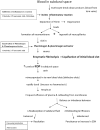The Role of Medical Treatment in Chronic Subdural Hematoma
- PMID: 30459852
- PMCID: PMC6208261
- DOI: 10.4103/ajns.AJNS_13_17
The Role of Medical Treatment in Chronic Subdural Hematoma
Abstract
Surgery is the standard treatment for chronic subdural hematoma (CSDH), one of the common problems in neurosurgical practice. Although medical treatment was used by some authors and found some positive results, it is not accepted by many authors. The aim of this review is to give overall view of the medical management of CSDH. Action of various drugs in the pathophysiological cascade of formation of CSDH was depicted. The review of literature is done under three headings - the primary medical treatment of CSDH, adjuvant medical treatment with surgery, and the treatment of the recurrence. Various classifications of CSDH and the factors influencing the outcome of medical treatment are discussed. There is a role of medical treatment in a selected group of patients with CSDH. Well-designed, multicenter, randomized controlled trials are required to define the indications and standard protocols for the medical treatment of CSDH.
Keywords: Chronic subdural hematoma; classification of chronic subdural hematoma; conservative management; medical treatment; nonsurgical treatment.
Conflict of interest statement
There are no conflicts of interest.
Figures
Similar articles
-
Tranexamic Acid in Chronic Subdural Hematomas (TRACS): study protocol for a randomized controlled trial.Trials. 2016 May 5;17(1):235. doi: 10.1186/s13063-016-1358-5. Trials. 2016. PMID: 27150916 Free PMC article. Clinical Trial.
-
Pathophysiology and Nonsurgical Treatment of Chronic Subdural Hematoma: From Past to Present to Future.World Neurosurg. 2018 Aug;116:402-411.e2. doi: 10.1016/j.wneu.2018.05.037. Epub 2018 May 14. World Neurosurg. 2018. PMID: 29772364 Review.
-
Prevalence of and risk factors for recurrence of chronic subdural hematoma.Acta Neurochir (Wien). 2018 May;160(5):893-899. doi: 10.1007/s00701-018-3513-0. Epub 2018 Mar 12. Acta Neurochir (Wien). 2018. PMID: 29532258
-
Drug treatment of chronic subdural hematoma.Expert Opin Pharmacother. 2020 Mar;21(4):435-444. doi: 10.1080/14656566.2020.1713095. Epub 2020 Jan 20. Expert Opin Pharmacother. 2020. PMID: 31957506 Review.
-
The Swedish study of Irrigation-fluid temperature in the evacuation of Chronic subdural hematoma (SIC!): study protocol for a multicenter randomized controlled trial.Trials. 2017 Oct 11;18(1):471. doi: 10.1186/s13063-017-2194-y. Trials. 2017. PMID: 29021000 Free PMC article. Clinical Trial.
Cited by
-
Hematoma-derived exosomes of chronic subdural hematoma promote abnormal angiogenesis and inhibit hematoma absorption through miR-144-5p.Aging (Albany NY). 2019 Dec 16;11(24):12147-12164. doi: 10.18632/aging.102550. Epub 2019 Dec 16. Aging (Albany NY). 2019. PMID: 31841443 Free PMC article.
-
Middle Meningeal Artery Embolization: A Paradigm Shift in Approach of Chronic Subdural Hematoma.J Community Hosp Intern Med Perspect. 2022 Sep 9;12(5):25-35. doi: 10.55729/2000-9666.1086. eCollection 2022. J Community Hosp Intern Med Perspect. 2022. PMID: 36262498 Free PMC article. Review.
-
Impact of angiotensin-converting enzyme inhibition on outcomes after middle meningeal artery embolization in patients with chronic subdural hematoma: A multinational, multi-institutional database study.Interv Neuroradiol. 2025 May 21:15910199251345042. doi: 10.1177/15910199251345042. Online ahead of print. Interv Neuroradiol. 2025. PMID: 40398492 Free PMC article.
-
Middle Meningeal Artery Embolization and the Treatment of a Chronic Subdural Hematoma.Cureus. 2021 Oct 18;13(10):e18868. doi: 10.7759/cureus.18868. eCollection 2021 Oct. Cureus. 2021. PMID: 34754700 Free PMC article. Review.
-
Chronic subdural hematoma: Clinical experience and recurrence risk factors in a Mexican neurosurgery residency training program.Surg Neurol Int. 2025 May 16;16:181. doi: 10.25259/SNI_71_2025. eCollection 2025. Surg Neurol Int. 2025. PMID: 40469361 Free PMC article.
References
-
- Kageyama H, Toyooka T, Tsuzuki N, Oka K. Nonsurgical treatment of chronic subdural hematoma with tranexamic acid. J Neurosurg. 2013;119:332–7. - PubMed
-
- Hirashima Y, Kurimoto M, Nagai S, Hori E, Origasa H, Endo S. Effect of platelet-activating factor receptor antagonist, etizolam, on resolution of chronic subdural hematoma – A prospective study to investigate use as conservative therapy. Neurol Med Chir (Tokyo) 2005;45:621–6. - PubMed
-
- Wang D, Li T, Tian Y, Wang S, Jin C, Wei H, et al. Effects of atorvastatin on chronic subdural hematoma: A preliminary report from three medical centers. J Neurol Sci. 2014;336:237–42. - PubMed
-
- Bender MB, Christoff N. Nonsurgical treatment of subdural hematomas. Arch Neurol. 1974;31:73–9. - PubMed
-
- Pichert G, Henn V. Conservative therapy of chronic subdural hematomas. Schweiz Med Wochenschr. 1987;117:1856–62. - PubMed



